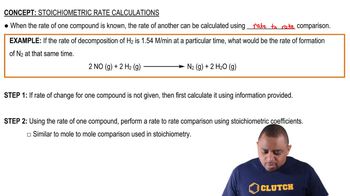Here are the essential concepts you must grasp in order to answer the question correctly.
Equilibrium Constant (Kc)
The equilibrium constant (Kc) is a numerical value that expresses the ratio of the concentrations of products to reactants at equilibrium for a given reaction at a specific temperature. For the reaction PH₃BCl₃(s) ⇌ PH₃(g) + BCl₃(g), Kc = [PH₃][BCl₃] / [PH₃BCl₃]. A small Kc value, like 1.87×10⁻³, indicates that at equilibrium, the concentration of reactants is much greater than that of products.
Recommended video:
Equilibrium Constant Expressions
Le Chatelier's Principle
Le Chatelier's Principle states that if a dynamic equilibrium is disturbed by changing the conditions, the system will adjust itself to counteract the change and restore a new equilibrium. In this case, adding PH₃BCl₃(s) will shift the equilibrium towards the products, PH₃(g) and BCl₃(g), until a new balance is achieved.
Recommended video:
Stoichiometry and Concentration Calculations
Stoichiometry involves using the coefficients of a balanced chemical equation to relate the amounts of reactants and products. To find the equilibrium concentrations of PH₃ and BCl₃, one must set up an ICE (Initial, Change, Equilibrium) table based on the stoichiometry of the reaction and the initial amount of PH₃BCl₃(s) added, considering the volume of the flask to convert moles to concentrations.
Recommended video:
Stoichiometric Rate Calculations




